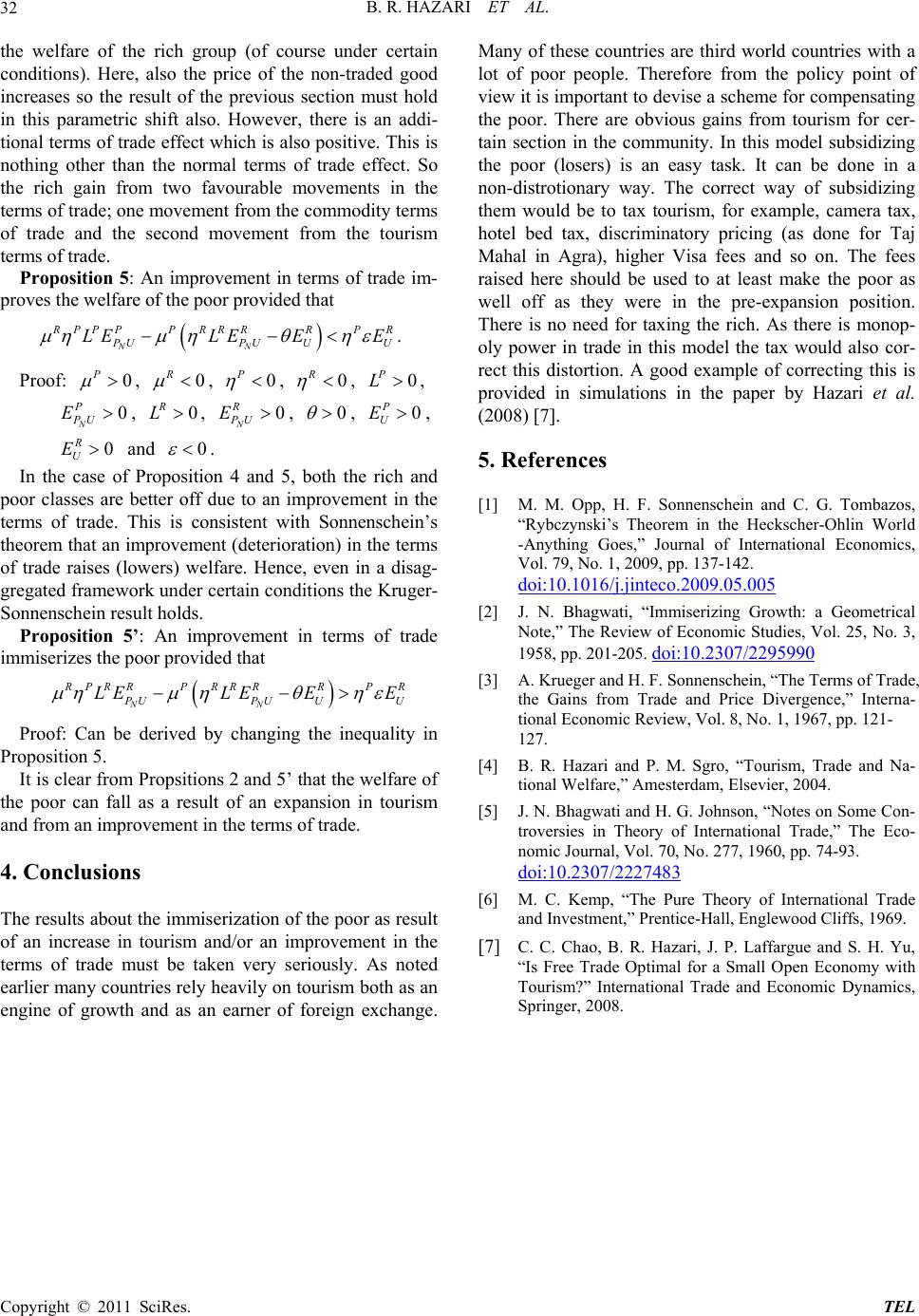
B. R. HAZARI ET AL.
Copyright © 2011 SciRes. TEL
32
the welfare of the rich group (of course under certain
conditions). Here, also the price of the non-traded good
increases so the result of the previous section must hold
in this parametric shift also. However, there is an addi-
tional terms of trade effect which is also positive. This is
nothing other than the normal terms of trade effect. So
the rich gain from two favourable movements in the
terms of trade; one movement from the commodity terms
of trade and the second movement from the tourism
terms of trade.
Proposition 5: An improvement in terms of trade im-
proves the welfare of the poor provide d that
NN
PP PPRR RRPR
UPUU
LELE EE
U
.
Proof: , , , , , 0
P
0
R
0
P
0
R
0
P
L
, , , 0
N
P
PU
E0
R
L0
N
R
PU
E0
, , 0
P
U
E
and
0
R
U
E0
.
In the case of Proposition 4 and 5, both the rich and
poor classes are better off due to an improvement in the
terms of trade. This is consistent with Sonnenschein’s
theorem that an improvement (deterioration) in the terms
of trade raises (lowers) welfare. Hence, even in a disag-
gregated framework under certain conditions the Kruger-
Sonnenschein result holds.
Proposition 5’: An improvement in terms of trade
immiserizes the poor provided that
NN
PR RPRR RRPR
UPUU
LELE EE
U
Proof: Can be derived by changing the inequality in
Proposition 5.
It is clear from Propsitions 2 and 5’ that the welfare of
the poor can fall as a result of an expansion in tourism
and from an improvement in the terms of trade.
4. Conclusions
The results about the immiserization of the poor as result
of an increase in tourism and/or an improvement in the
terms of trade must be taken very seriously. As noted
earlier many countries rely heavily on tourism both as an
engine of growth and as an earner of foreign exchange.
Many of these countries are third world countries with a
lot of poor people. Therefore from the policy point of
view it is important to devise a scheme for compensating
the poor. There are obvious gains from tourism for cer-
tain section in the community. In this model subsidizing
the poor (losers) is an easy task. It can be done in a
non-distrotionary way. The correct way of subsidizing
them would be to tax tourism, for example, camera tax,
hotel bed tax, discriminatory pricing (as done for Taj
Mahal in Agra), higher Visa fees and so on. The fees
raised here should be used to at least make the poor as
well off as they were in the pre-expansion position.
There is no need for taxing the rich. As there is monop-
oly power in trade in this model the tax would also cor-
rect this distortion. A good example of correcting this is
provided in simulations in the paper by Hazari et al.
(2008) [7].
5. References
[1] M. M. Opp, H. F. Sonnenschein and C. G. Tombazos,
“Rybczynski’s Theorem in the Heckscher-Ohlin World
-Anything Goes,” Journal of International Economics,
Vol. 79, No. 1, 2009, pp. 137-142.
doi:10.1016/j.jinteco.2009.05.005
[2] J. N. Bhagwati, “Immiserizing Growth: a Geometrical
Note,” The Review of Economic Studies, Vol. 25, No. 3,
1958, pp. 201-205. doi:10.2307/2295990
[3] A. Krueger and H. F. Sonnenschein, “The Terms of Trade,
the Gains from Trade and Price Divergence,” Interna-
tional Economic Review, Vol. 8, No. 1, 1967, pp. 121-
127.
[4] B. R. Hazari and P. M. Sgro, “Tourism, Trade and Na-
tional Welfare,” Amesterdam, Elsevier, 2004.
[5] J. N. Bhagwati and H. G. Johnson, “Notes on Some Con-
troversies in Theory of International Trade,” The Eco-
nomic Journal, Vol. 70, No. 277, 1960, pp. 74-93.
doi:10.2307/2227483
[6] M. C. Kemp, “The Pure Theory of International Trade
and Investment,” Prentice-Hall, Englewood Cliffs, 1969.
[7] C. C. Chao, B. R. Hazari, J. P. Laffargue and S. H. Yu,
“Is Free Trade Optimal for a Small Open Economy with
Tourism?” International Trade and Economic Dynamics,
Springer, 2008.